Network slicing has become a fundamental property for next-generation networks, especially because an inherent part of 5G standardisation is the ability for service providers to migrate some or all of their network services to a virtual network infrastructure, thereby reducing both capital and operational costs. With network function virtualisation (NFV), network functions (NFs) such as firewalls, traffic load balancers, content filters, and intrusion detection systems (IDS) are either instantiated on virtual machines (VMs) or lightweight containers, often chained together to create a service function chain (SFC).
In this work, we review the state-of-the-art NFV and SFC implementation frameworks and present a taxonomy of the current proposals. Our taxonomy comprises three major categories based on the primary objectives of each of the surveyed frameworks: (1) resource allocation and service orchestration, (2) performance tuning, and (3) resilience and fault recovery. We also identify some key open research challenges that require further exploration by the research community to achieve scalable, resilient, and high-performance NFV/SFC deployments in next-generation networks.
- Software-defined Networking
- Network function Virtualisation
- Service Function Chain
- 5G
- Virtualization
- Networks
- Next-generation Networks
- vnf
- Distributed Systems
1. Introduction
-
We present the vNF chaining requirements (Section 2.1) and how they relate to SFC implementations in service provider networks, thus some use cases for the SFC paradigm (Section 2.2) are presented. An overview of the current state-of-the-art SDN, NFV, and SFC (Section 3) is also presented as the foundation for the frameworks reviewed in this paper;
-
We present a comprehensive survey of the state-of-the-art NFV frameworks for building and implementing vNFs, particularly frameworks that have been proposed for use in SFC environments. We also present a taxonomy of SFC implementation frameworks, focusing on each SFC-related challenge, each one addressing the approaches used (Section 4);
-
Finally, we identify and discuss the main open research challenges associated with NFV and SFC environments in the next generation networks (Section 5).
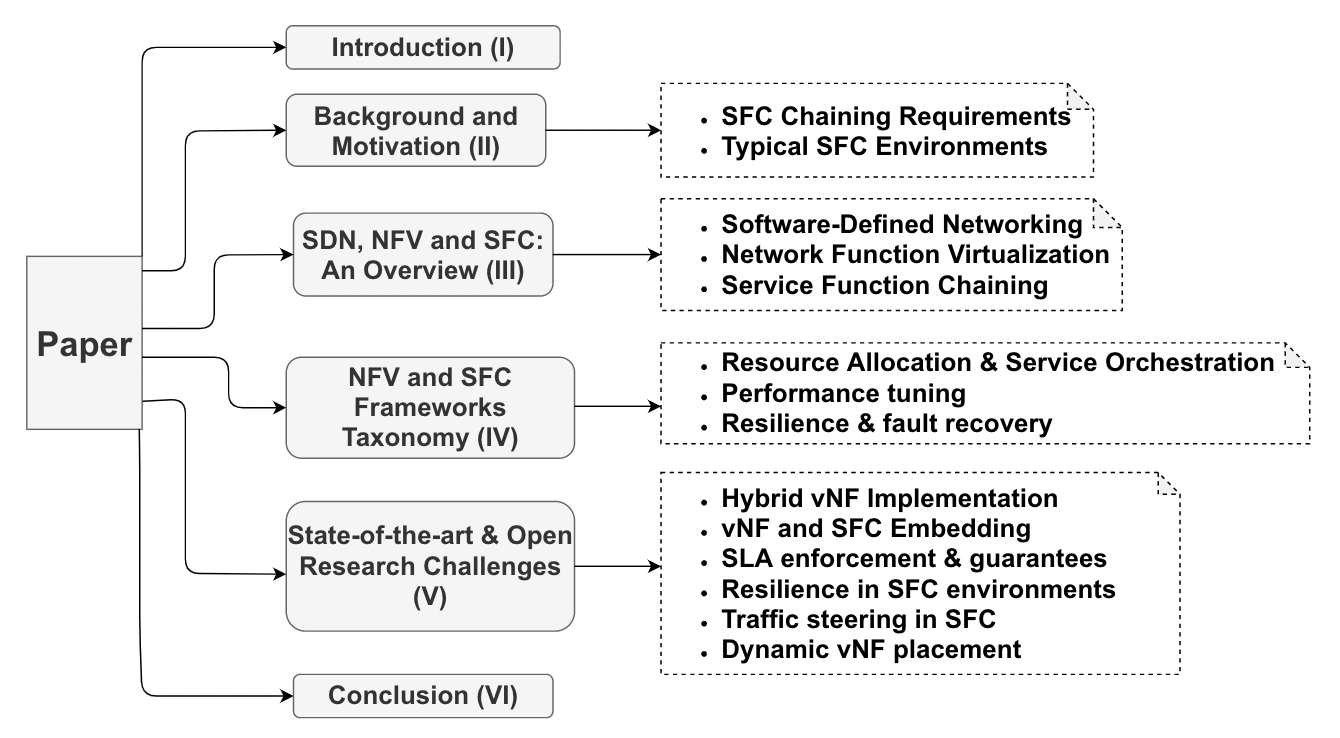 Figure 1. High-level paper structure.
Figure 1. High-level paper structure.Research Methodology

2. Background and Motivation
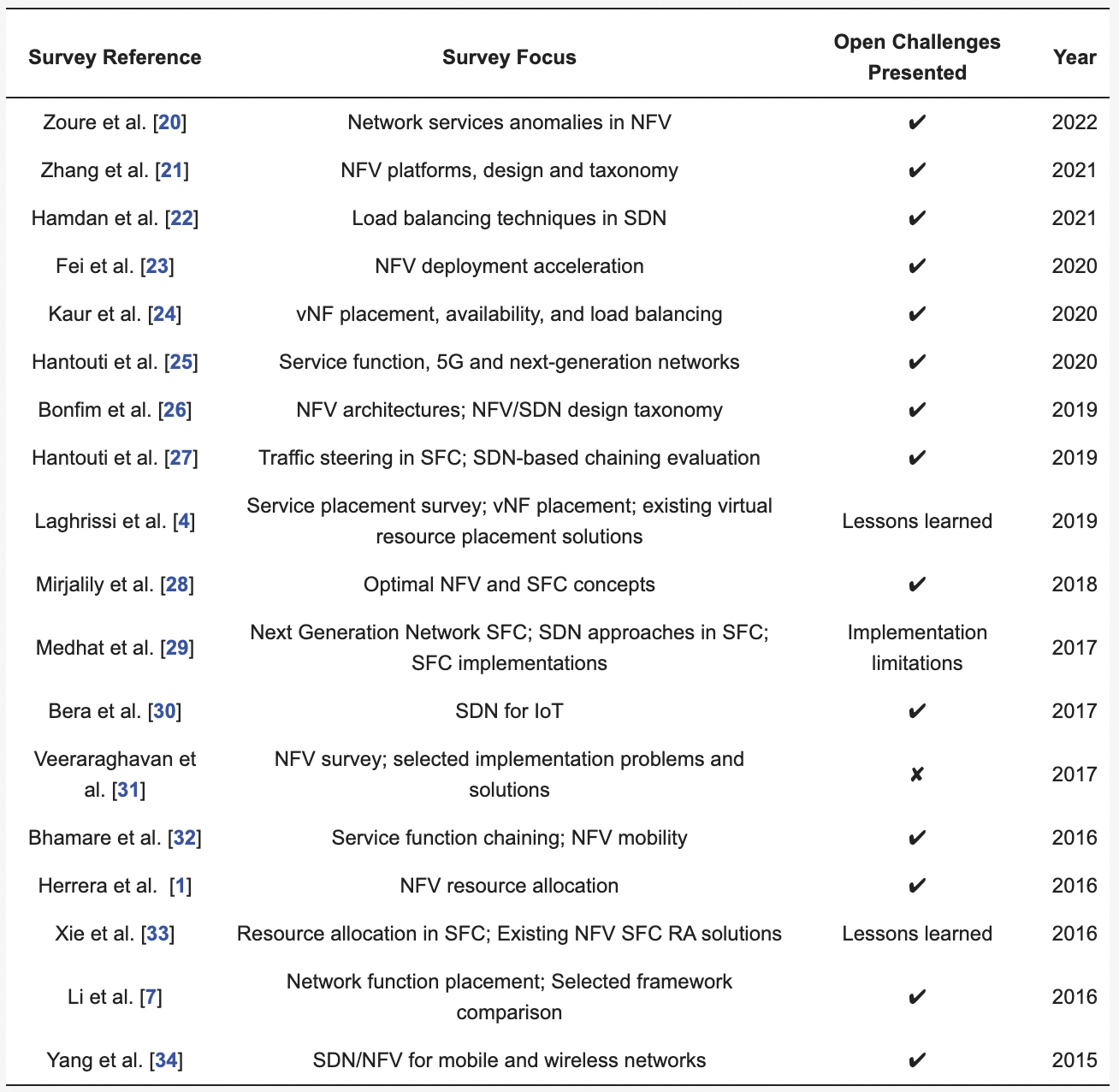
2.1. SFC Chaining Requirements
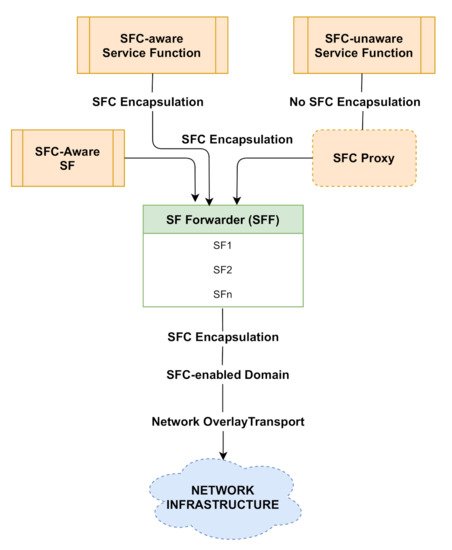
2.2. Typical SFC Environments
2.2.1. The Gi-LAN Mobile Core Network

2.2.2. Residential and Consumer Services
2.2.3. Inter-and Intra-Data-Centre Networks
3. SDN, NFV and SFC: An Overview
1.1. Software-Defined Networking
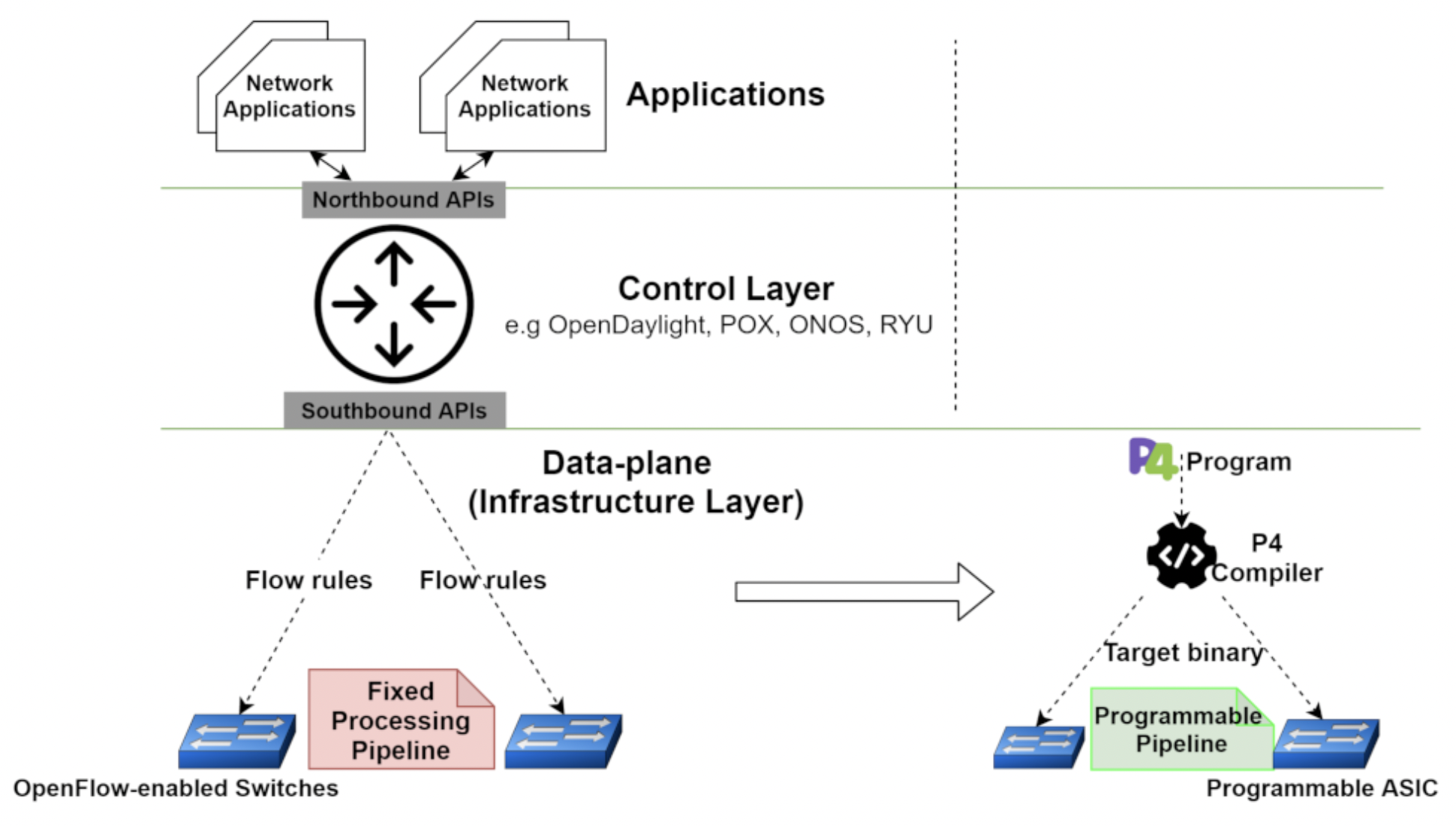
3.2. Network Function Virtualization
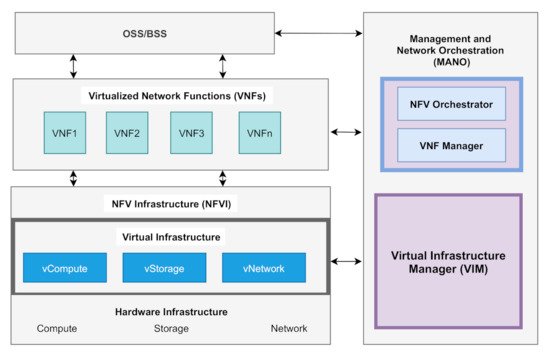
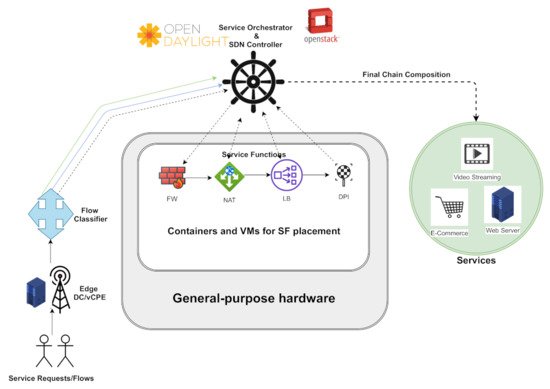
3.3. Service Function Chaining
3.4. NFV/SFC and 5G Networks
4. NFV and SFC Frameworks Taxonomy
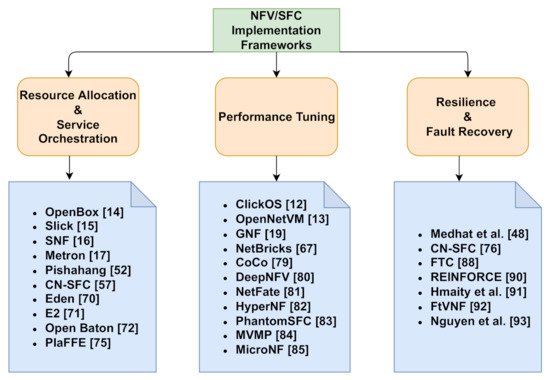
4.1. Resource Allocation and Service Orchestration Frameworks
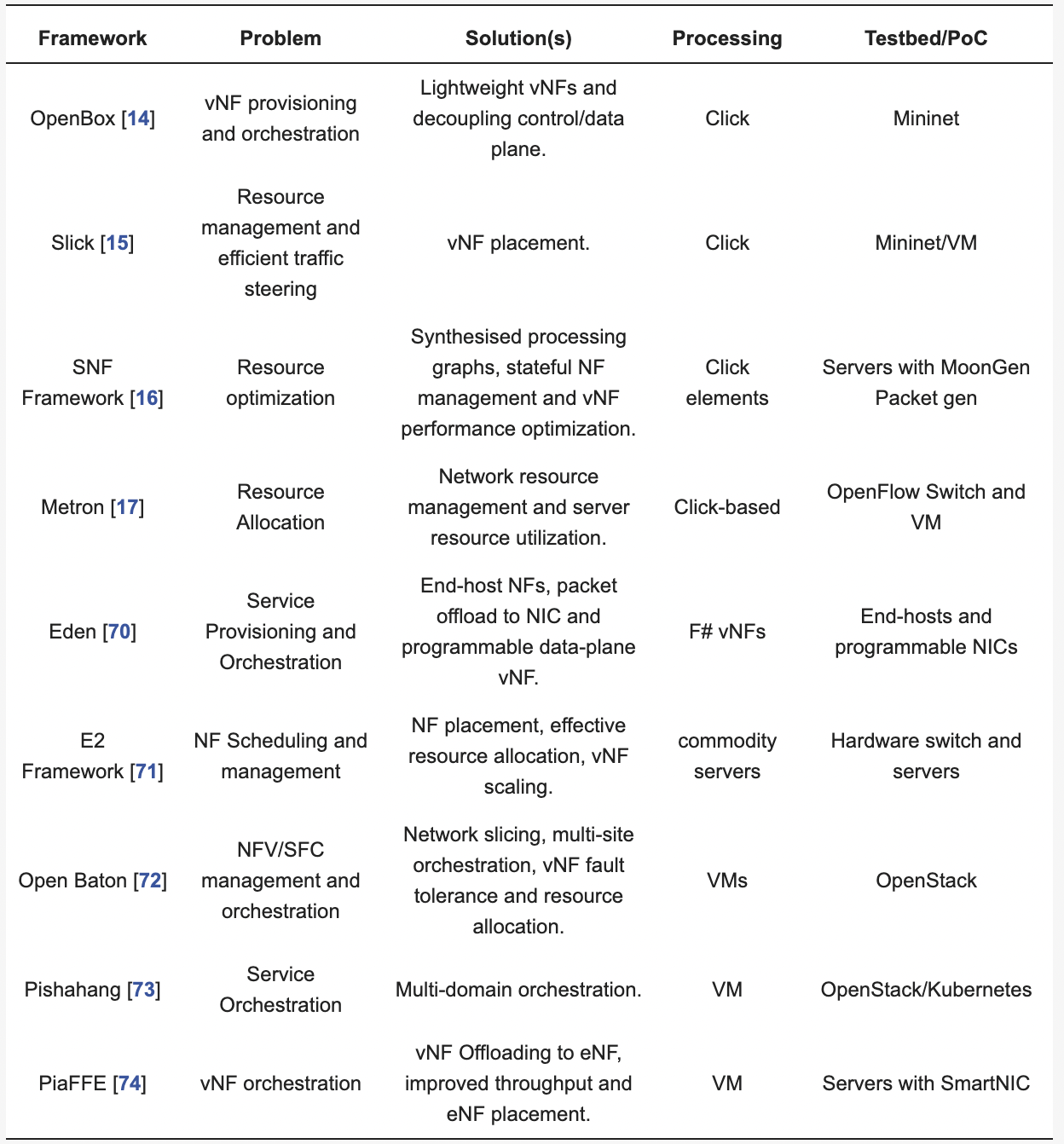
4.1.1. Eden Framework
4.1.2. E2 Framework
4.1.3. Pishahang Framework
4.1.4. SNF Framework
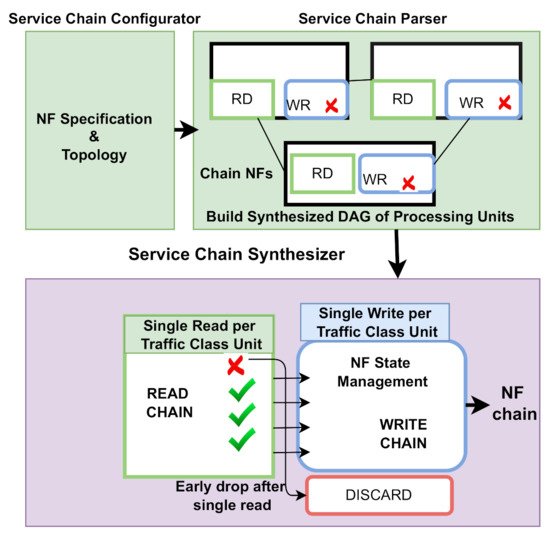
4.1.5. Open Baton Framework
4.1.6. Metron Framework
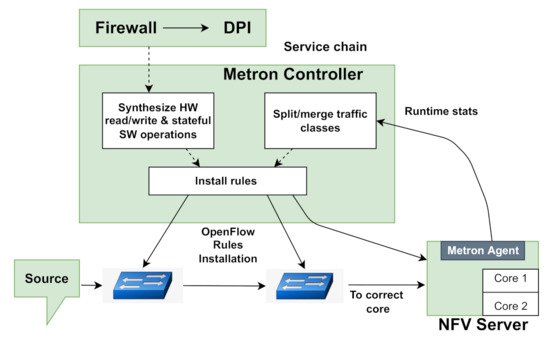
4.1.7. CN-SFC Framework
4.1.8. Slick Framework
4.1.9. Openbox Framework
4.1.10. Piaffe Framework
4.2. Performance Tuning Frameworks
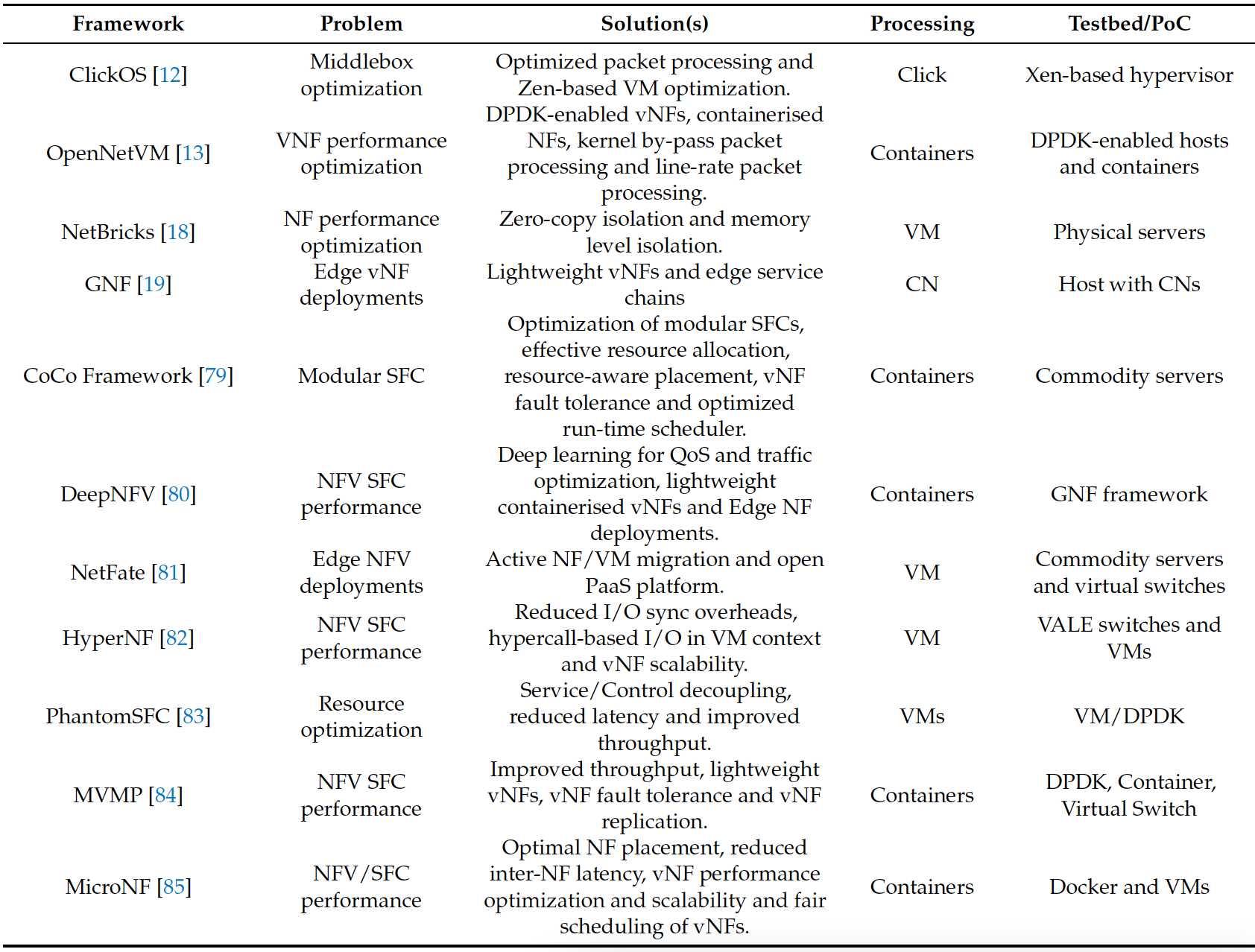
4.2.1. Coco Framework
4.2.2. Deepnfv Framework
4.2.3. Micronf Framework
4.2.4. Netbricks Framework
4.2.5. Hypernf Framework
4.2.6. Netfate Framework
4.2.7. Clickos Framework
4.2.8. Opennetvm Framework
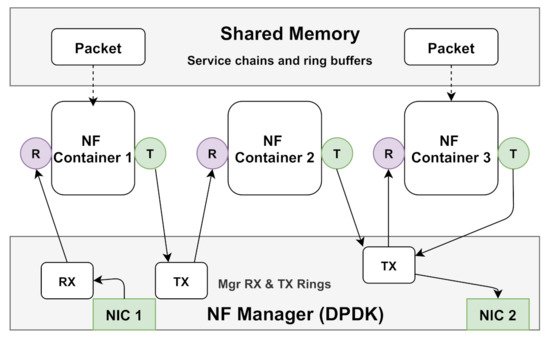
4.2.9. Phantomsfc Framework
4.2.10. GNF Framework
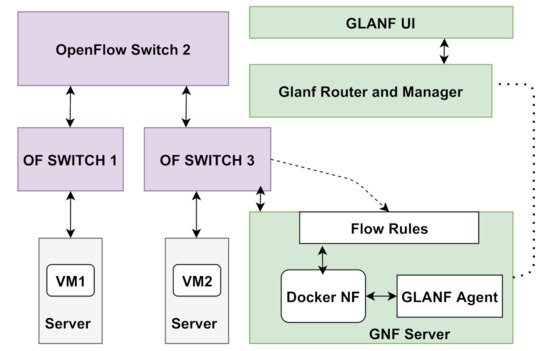
4.2.11. MVMP Framework
4.3. Resilience and Fault Recovery Frameworks
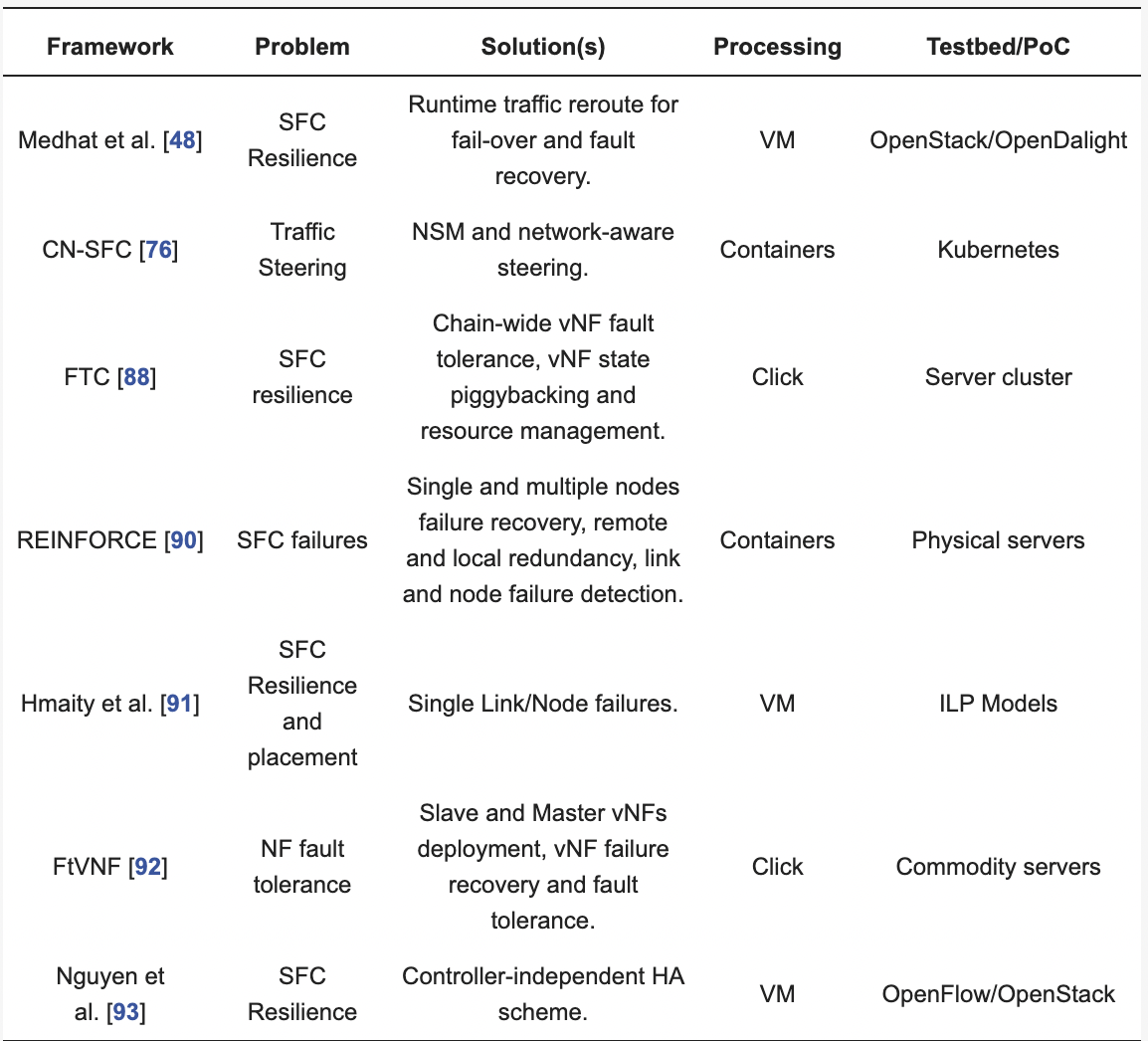
4.3.1. Reinforce Framework
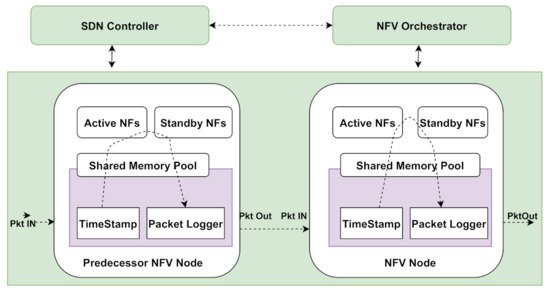
4.3.2. FTC Framework
4.3.3. Hmaity et al.
4.3.4. Resilient SFCs—Medhat et al.
4.3.5. OpenFlow Fault Recovery
5. State-of-the-Art and Open Challenges
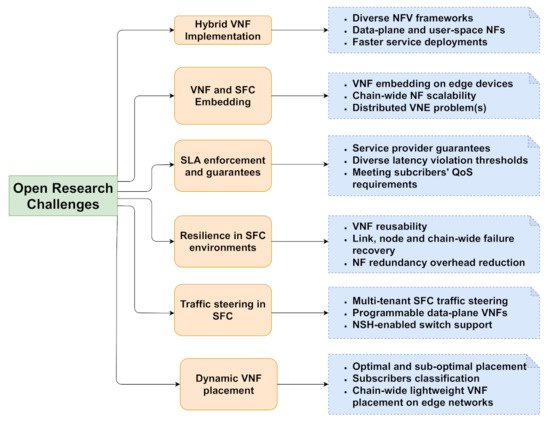
5.1. Hybrid vNF Implementation
5.2. vNF and SFC Embedding
5.3. SLA Enforcement and Guarantees
5.4. Resilience in SFC Environments
5.5. Traffic Steering in SFC
5.6. Dynamic vNF Placement
6. Conclusions
Author Contributions
Funding
Institutional Review Board Statement
Informed Consent Statement
Data Availability Statement
Conflicts of Interest
Abbreviations
| Abbreviation | Meaning |
| API | Application programming interface |
| CAPEX | Capital expenditure |
| CL | Classifier |
| CNF | Cloud-native function |
| DMA | Direct memory access |
| DPI | Deep packet inspection |
| eNF | embedded network function |
| ETSI | European Telecommunication Standards Institute |
| FPGA | Field-programmable gate array |
| EPC | Evolved packet core |
| ITU | International telecommunication union |
| IDS | Intrusion detection system |
| ILP | Integer linear programming |
| IoT | Internet of Things |
| IPS | Intrusion prevention system |
| PCAP | Packet capture |
| PoC | Proof of concept |
| RSS | Receive side scaling |
| SC | Service Chain |
| SDN | Software-defined networking |
| SFF | Service function forwarder |
| SP | Service provider |
| SF | Service function |
| SFCC | Service function chaining controller |
| MAC | Media access control |
| ML | Machine learning |
| NAT | Network address translation |
| NFV | Network function virtualization |
| NSH | Network service header |
| NFVI | NFV infrastructure |
| NFVO | NFV Orchestrator |
| NS | Network service |
| NFF | Network function forwarder |
| OF | OpenFlow |
| OPEX | Operational expenditure |
| QoS | Quality of service |
| QoE | Quality of experience |
| vCPE | virtual customer premises equipment |
| VNE | Virtual network embedding |
| VoIP | Voice over Internet Protocol |
| vNF | Virtual network function |
| VNFC | Virtual network function component |
| SFC | Service function chaining |
| VIM | Virtual infrastructure manager |
References
- Herrera, J.G.; Botero, J.F. Resource allocation in NFV: A comprehensive survey. IEEE Trans. Netw. Serv. Manag. 2016, 13, 518–532. [Google Scholar] [CrossRef]
- Cherrared, S.; Imadali, S.; Fabre, E.; Gössler, G.; Yahia, I.G.B. A survey of fault management in network virtualization environments: Challenges and solutions. IEEE Trans. Netw. Serv. Manag. 2019, 16, 1537–1551. [Google Scholar] [CrossRef]
- Paganelli, F.; Cappanera, P.; Cuffaro, G. Tenant-defined service function chaining in a multi-site network slice. Future Gener. Comput. Syst. 2021, 121, 1–18. [Google Scholar] [CrossRef]
- Laghrissi, A.; Taleb, T. A survey on the placement of virtual resources and virtual network functions. IEEE Commun. Surv. Tutor. 2018, 21, 1409–1434. [Google Scholar] [CrossRef]
- Bujari, A.; Palazzi, C.E.; Polonio, D.; Zanella, M. Service function chaining: A lightweight container-based management and orchestration plane. In Proceedings of the 2019 16th IEEE Annual Consumer Communications & Networking Conference (CCNC), Las Vegas, NV, USA, 11–14 January 2019; pp. 1–4. [Google Scholar]
- Santos, J.; Wauters, T.; Volckaert, B.; De Turck, F. Towards delay-aware container-based service function chaining in fog computing. In Proceedings of the NOMS 2020-2020 IEEE/IFIP Network Operations and Management Symposium, Budapest, Hungary, 20–24 April 2020; pp. 1–9. [Google Scholar]
- Li, X.; Qian, C. A survey of network function placement. In Proceedings of the 2016 13th IEEE Annual Consumer Communications & Networking Conference (CCNC), Las Vegas, NV, USA, 9–12 January 2016; pp. 948–953. [Google Scholar]
- Haleplidis, E.; Joachimpillai, D.; Salim, J.H.; Lopez, D.; Martin, J.; Pentikousis, K.; Denazis, S.; Koufopavlou, O. ForCES applicability to SDN-enhanced NFV. In Proceedings of the 2014 Third European Workshop on Software Defined Networks, Budapest, Hungary, 1–3 September 2014; pp. 43–48. [Google Scholar]
- Liu, J.; Lu, W.; Zhou, F.; Lu, P.; Zhu, Z. On dynamic service function chain deployment and readjustment. IEEE Trans. Netw. Serv. Manag. 2017, 14, 543–553. [Google Scholar] [CrossRef]
- Chua, F.C.; Ward, J.; Zhang, Y.; Sharma, P.; Huberman, B.A. Stringer: Balancing latency and resource usage in service function chain provisioning. IEEE Internet Comput. 2016, 20, 22–31. [Google Scholar] [CrossRef]
- Bhamare, D.; Samaka, M.; Erbad, A.; Jain, R.; Gupta, L.; Chan, H.A. Optimal virtual network function placement in multi-cloud service function chaining architecture. Comput. Commun. 2017, 102, 1–16. [Google Scholar] [CrossRef]
- Martins, J.; Ahmed, M.; Raiciu, C.; Olteanu, V.; Honda, M.; Bifulco, R.; Huici, F. ClickOS and the art of network function virtualization. In Proceedings of the 11th USENIX Symposium on Networked Systems Design and Implementation (NSDI 14), Seattle, WA, USA, 2–4 April 2014; pp. 459–473. [Google Scholar]
- Zhang, W.; Liu, G.; Zhang, W.; Shah, N.; Lopreiato, P.; Todeschi, G.; Ramakrishnan, K.; Wood, T. OpenNetVM: A platform for high performance network service chains. In Proceedings of the 2016 Workshop on Hot topics in Middleboxes and Network Function Virtualization, Florianopolis, Brazil, 22 August 2016; pp. 26–31. [Google Scholar]
- Bremler-Barr, A.; Harchol, Y.; Hay, D. OpenBox: A software-defined framework for developing, deploying, and managing network functions. In Proceedings of the 2016 ACM SIGCOMM Conference, Florianopolis, Brazil, 22 August 2016; pp. 511–524. [Google Scholar]
- Anwer, B.; Benson, T.; Feamster, N.; Levin, D. Programming slick network functions. In Proceedings of the 1st ACM Sigcomm Symposium on Software Defined Networking Research, Santa Clara, CA, USA, 17 June 2015; pp. 1–13. [Google Scholar]
- Katsikas, G.P.; Enguehard, M.; Kuźniar, M.; Maguire Jr, G.Q.; Kostić, D. SNF: Synthesizing high performance NFV service chains. PeerJ Comput. Sci. 2016, 2, e98. [Google Scholar] [CrossRef]
- Katsikas, G.P.; Barbette, T.; Kostic, D.; Steinert, R.; Maguire, G.Q., Jr. Metron: NFV Service Chains at the True Speed of the Underlying Hardware. In Proceedings of the 15th USENIX Symposium on Networked Systems Design and Implementation (NSDI 18), Renton, WA, USA, 9–11 April 2018; pp. 171–186. [Google Scholar]
- Panda, A.; Han, S.; Jang, K.; Walls, M.; Ratnasamy, S.; Shenker, S. NetBricks: Taking the V out of NFV. In Proceedings of the 12th USENIX Symposium on Operating Systems Design and Implementation (OSDI 16), Savannah, GA, USA, 2 November 2016; pp. 203–216. [Google Scholar]
- Cziva, R.; Jouet, S.; White, K.J.; Pezaros, D.P. Container-based network function virtualization for software-defined networks. In Proceedings of the 2015 IEEE Symposium on Computers and Communication (ISCC), Larnaca, Cyprus, 6–9 July 2015; pp. 415–420. [Google Scholar]
- Zoure, M.; Ahmed, T.; Réveillére, L. Network Services Anomalies in NFV: Survey, Taxonomy, and Verification Methods. IEEE Trans. Netw. Serv. Manag. 2022. [Google Scholar] [CrossRef]
- Zhang, T.; Qiu, H.; Linguaglossa, L.; Cerroni, W.; Giaccone, P. NFV platforms: Taxonomy, design choices and future challenges. IEEE Trans. Netw. Serv. Manag. 2020, 18, 30–48. [Google Scholar] [CrossRef]
- Hamdan, M.; Hassan, E.; Abdelaziz, A.; Elhigazi, A.; Mohammed, B.; Khan, S.; Vasilakos, A.V.; Marsono, M.N. A comprehensive survey of load balancing techniques in software-defined network. J. Netw. Comput. Appl. 2021, 174, 102856. [Google Scholar] [CrossRef]
- Fei, X.; Liu, F.; Zhang, Q.; Jin, H.; Hu, H. Paving the Way for NFV Acceleration: A Taxonomy, Survey and Future Directions. ACM Comput. Surv. (CSUR) 2020, 53, 1–42. [Google Scholar] [CrossRef]
- Kaur, K.; Mangat, V.; Kumar, K. A comprehensive survey of service function chain provisioning approaches in SDN and NFV architecture. Comput. Sci. Rev. 2020, 38, 100298. [Google Scholar] [CrossRef]
- Hantouti, H.; Benamar, N.; Taleb, T. Service Function Chaining in 5G and Beyond Networks: Challenges and Open Research Issues. IEEE Netw. 2020, 34, 320–327. [Google Scholar] [CrossRef]
- Bonfim, M.S.; Dias, K.L.; Fernandes, S.F. Integrated NFV/SDN architectures: A systematic literature review. ACM Comput. Surv. (CSUR) 2019, 51, 1–39. [Google Scholar] [CrossRef]
- Hantouti, H.; Benamar, N.; Taleb, T.; Laghrissi, A. Traffic steering for service function chaining. IEEE Commun. Surv. Tutor. 2018, 21, 487–507. [Google Scholar] [CrossRef]
- Mirjalily, G.; Zhiquan, L. Optimal network function virtualization and service function chaining: A survey. Chin. J. Electron. 2018, 27, 704–717. [Google Scholar] [CrossRef]
- Medhat, A.M.; Taleb, T.; Elmangoush, A.; Carella, G.A.; Covaci, S.; Magedanz, T. Service function chaining in next generation networks: State of the art and research challenges. IEEE Commun. Mag. 2016, 55, 216–223. [Google Scholar] [CrossRef]
- Bera, S.; Misra, S.; Vasilakos, A.V. Software-defined networking for internet of things: A survey. IEEE Internet Things J. 2017, 4, 1994–2008. [Google Scholar] [CrossRef]
- Veeraraghavan, M.; Sato, T.; Buchanan, M.; Rahimi, R.; Okamoto, S.; Yamanaka, N. Network function virtualization: A survey. IEICE Trans. Commun. 2017, E100B, 1978–1991. [Google Scholar] [CrossRef]
- Bhamare, D.; Jain, R.; Samaka, M.; Erbad, A. A survey on service function chaining. J. Netw. Comput. Appl. 2016, 75, 138–155. [Google Scholar] [CrossRef]
- Xie, Y.; Liu, Z.; Wang, S.; Wang, Y. Service function chaining resource allocation: A survey. arXiv 2016, arXiv:1608.00095. [Google Scholar]
- Yang, M.; Li, Y.; Jin, D.; Zeng, L.; Wu, X.; Vasilakos, A.V. Software-defined and virtualized future mobile and wireless networks: A survey. Mob. Netw. Appl. 2015, 20, 4–18. [Google Scholar] [CrossRef]
- Quinn, P.; Beliveau, A. Service Function Chaining (SFC) Architecture. draft-quinn-sfc-arch-04. 2014. Available online: https://www.ietf.org/proceedings/89/slides/slides-89-sfc-10.pdf (accessed on 20 January 2022).
- Gasparakis, J.; Smith, K.; Zhou, D. Evaluating Dynamic Service Function Chaining for the Gi-LAN. In White Paper; Intel: Santa Clara, CA, USA, 2016. [Google Scholar]
- Halpern, J.; Pignataro, C. Service Function Chaining (sfc) Architecture. In RFC 7665; IETF: 2015; pp. 1–28. Available online: https://www.hjp.at/(de)/doc/rfc/rfc7665.html (accessed on 20 January 2022).
- Grønsund, P.; Mahmood, K.; Millstein, G.; Noy, A.; Solomon, G.; Sahai, A. A solution for SGi-LAN services virtualization using NFV and SDN. In Proceedings of the 2015 European Conference on Networks and Communications (EuCNC), Paris, France, 29 June–2 July 2015; pp. 408–412. [Google Scholar]
- Naik, P.; Vutukuru, M. libVNF: A Framework for Building Scalable High Performance Virtual Network Functions. In Proceedings of the 8th Asia-Pacific Workshop on Systems, Mumbai, India, 2 September 2017; pp. 1–8. [Google Scholar]
- Turk, Y.; Zeydan, E. An Implementation of Network Service Chaining for SDN-enabled Mobile Packet Data Networks. In Proceedings of the 2019 International Symposium on Networks, Computers and Communications (ISNCC), Istanbul, Turkey, 18–20 June 2019; pp. 1–6. [Google Scholar]
- Kaur, K.; Kumar, K.; Mangat, V. A road to network function virtualization and applications. Adv. Math. Sci. J. 2020, 9, 4059–4066. [Google Scholar] [CrossRef]
- Brown, G.; Reading, H. Service Chaining in Carrier Networks. Heavy Read. 2015. Available online: https://www.qosmos.com/wp-content/uploads/Service-Chaining-in-Carrier-Networks_WP_Heavy-Reading_Qosmos_Feb2015.pdf (accessed on 20 January 2022).
- Shojafar, M.; Pooranian, Z.; Sookhak, M.; Buyya, R. Recent advances in cloud data centers toward fog data centers. Concurr. Comput. Pract. Exp. 2019, 31, e5164. [Google Scholar] [CrossRef]
- Cunha, V.A.; Cardoso, I.D.; Barraca, J.P.; Aguiar, R.L. Policy-driven vCPE through dynamic network service function chaining. In Proceedings of the 2016 IEEE NetSoft Conference and Workshops (NetSoft), Seoul, Korea, 6–10 June 2016; pp. 156–160. [Google Scholar]
- Yan, Z.; Zhang, P.; Vasilakos, A.V. A security and trust framework for virtualized networks and software-defined networking. Secur. Commun. Netw. 2016, 9, 3059–3069. [Google Scholar] [CrossRef]
- Liu, Y.; Zhou, F.; Chen, C.; Zhu, Z.; Shang, T.; Torres-Moreno, J.M. Disaster protection in Inter-DataCenter networks leveraging cooperative storage. IEEE Trans. Netw. Serv. Manag. 2021, 18, 2598–2611. [Google Scholar] [CrossRef]
- Zhong, X.; Wang, Y.; Qiu, X. Service function chain orchestration across multiple clouds. China Commun. 2018, 15, 99–116. [Google Scholar] [CrossRef]
- Medhat, A.M.; Carella, G.A.; Pauls, M.; Monachesi, M.; Corici, M.; Magedanz, T. Resilient orchestration of Service Functions Chains in a NFV environment. In Proceedings of the 2016 IEEE Conference on Network Function Virtualization and Software Defined Networks (NFV-SDN), Palo Alto, CA, USA, 7–10 November 2016; pp. 7–12. [Google Scholar]
- Sarmiento, D.E.; Lebre, A.; Nussbaum, L.; Chari, A. Decentralized SDN Control Plane for a Distributed Cloud-Edge Infrastructure: A Survey. IEEE Commun. Surv. Tutor. 2021, 23, 256–281. [Google Scholar] [CrossRef]
- Medved, J.; Varga, R.; Tkacik, A.; Gray, K. Opendaylight: Towards a model-driven sdn controller architecture. In Proceeding of the IEEE International Symposium on a World of Wireless, Mobile and Multimedia Networks 2014, Sydney, NSW, Australia, 19 June 2014; pp. 1–6. [Google Scholar]
- Kaur, S.; Singh, J.; Ghumman, N.S. Network programmability using POX controller. In Proceedings of the International Conference on Communication, Computing & Systems (ICCCS); 2014; Volume 138, pp. 134–138. Available online: https://docplayer.net/11300937-Network-programmability-using-pox-controller.html (accessed on 20 January 2022).
- Zhang, T.; Linguaglossa, L.; Giaccone, P.; Iannone, L.; Roberts, J. Performance benchmarking of state-of-the-art software switches for NFV. Comput. Netw. 2021, 188, 107861. [Google Scholar] [CrossRef]
- Bosshart, P.; Daly, D.; Gibb, G.; Izzard, M.; McKeown, N.; Rexford, J.; Schlesinger, C.; Talayco, D.; Vahdat, A.; Varghese, G.; et al. P4: Programming protocol-independent packet processors. ACM SIGCOMM Comput. Commun. Rev. 2014, 44, 87–95. [Google Scholar] [CrossRef]
- ETSI. Network Functions Virtualisation (NFV): Architectural Framework; Technical Report 002 V1.1.1; 2013. Available online: https://www.etsi.org/deliver/etsi_gs/NFV/001_099/002/01.01.01_60/gs_NFV002v010101p.pdf (accessed on 20 January 2022).
- Binu, A.; Kumar, G.S. Virtualization techniques: A methodical review of XEN and KVM. In International Conference on Advances in Computing and Communications; Springer: Berlin/Heidelberg, Germany, 2011; pp. 399–410. [Google Scholar]
- Wray, M.J.; Dalton, C.I. Network Virtualization. US Patent 8,223,770, 17 July 2012. Available online: https://uspto.report/patent/grant/8,223,770 (accessed on 20 January 2022).
- Wang, M.; Cheng, B.; Wang, S.; Chen, J. Availability-and traffic-aware placement of parallelized SFC in data center networks. IEEE Trans. Netw. Serv. Manag. 2021, 18, 182–194. [Google Scholar] [CrossRef]
- Özdem, M.; Alkan, M. Subscriber aware dynamic service function chaining. Comput. Netw. 2021, 194, 108138. [Google Scholar] [CrossRef]
- Li, Y.; Chen, M. Software-defined network function virtualization: A survey. IEEE Access 2015, 3, 2542–2553. [Google Scholar]
- Yousaf, F.Z.; Bredel, M.; Schaller, S.; Schneider, F. NFV and SDN—Key technology enablers for 5G networks. IEEE J. Sel. Areas Commun. 2017, 35, 2468–2478. [Google Scholar] [CrossRef]
- Kak, A. Towards 6G Through SDN and NFV-Based Solutions for Terrestrial and Non-Terrestrial Networks. Ph.D. Thesis, Georgia Institute of Technology, Atlanta, GA, USA, 2021. [Google Scholar]
- Qadri, Y.A.; Nauman, A.; Zikria, Y.B.; Vasilakos, A.V.; Kim, S.W. The future of healthcare internet of things: A survey of emerging technologies. IEEE Commun. Surv. Tutor. 2020, 22, 1121–1167. [Google Scholar] [CrossRef]
- Huang, M.; Liu, A.; Xiong, N.N.; Wang, T.; Vasilakos, A.V. An effective service-oriented networking management architecture for 5G-enabled internet of things. Comput. Netw. 2020, 173, 107208. [Google Scholar] [CrossRef]
- Morocho-Cayamcela, M.E.; Lee, H.; Lim, W. Machine learning for 5G/B5G mobile and wireless communications: Potential, limitations, and future directions. IEEE Access 2019, 7, 137184–137206. [Google Scholar] [CrossRef]
- Berardinelli, G.; Mahmood, N.H.; Rodriguez, I.; Mogensen, P. Beyond 5G wireless IRT for industry 4.0: Design principles and spectrum aspects. In Proceedings of the 2018 IEEE Globecom Workshops (GC Wkshps), Abu Dhabi, United Arab Emirates, 9–13 December 2018; pp. 1–6. [Google Scholar]
- Katz, M.; Matinmikko-Blue, M.; Latva-Aho, M. 6Genesis flagship program: Building the bridges towards 6G-enabled wireless smart society and ecosystem. In Proceedings of the 2018 IEEE 10th Latin-American Conference on Communications (LATINCOM), Guadalajara, Mexico, 14–16 November 2018; pp. 1–9. [Google Scholar]
- Abdelwahab, S.; Hamdaoui, B.; Guizani, M.; Znati, T. Network function virtualization in 5G. IEEE Commun. Mag. 2016, 54, 84–91. [Google Scholar] [CrossRef]
- Huang, H.; Zeng, C.; Zhao, Y.; Min, G.; Zhu, Y.Y.; Miao, W.; Hu, J. Scalable Service Function Chain Orchestration in NFV-enabled Networks: A Federated Reinforcement Learning Approach. IEEE J. Sel. Areas Commun. 2021, 39, 2558–2571. [Google Scholar] [CrossRef]
- Sun, G.; Xu, Z.; Yu, H.; Chen, X.; Chang, V.; Vasilakos, A.V. Low-latency and resource-efficient service function chaining orchestration in network function virtualization. IEEE Internet Things J. 2019, 7, 5760–5772. [Google Scholar] [CrossRef]
- Ballani, H.; Costa, P.; Gkantsidis, C.; Grosvenor, M.P.; Karagiannis, T.; Koromilas, L.; O’Shea, G. Enabling end-host network functions. ACM SIGCOMM Comput. Commun. Rev. 2015, 45, 493–507. [Google Scholar] [CrossRef]
- Palkar, S.; Lan, C.; Han, S.; Jang, K.; Panda, A.; Ratnasamy, S.; Rizzo, L.; Shenker, S. E2: A framework for NFV applications. In Proceedings of the 25th Symposium on Operating Systems Principles, Monterey, CA, USA, 4 October 2015; pp. 121–136. [Google Scholar]
- Carella, G.A.; Magedanz, T. Open baton: A framework for virtual network function management and orchestration for emerging software-based 5G networks. Newsletter 2015, 2016, 190. [Google Scholar]
- Kouchaksaraei, H.R.; Dierich, T.; Karl, H. Pishahang: Joint orchestration of network function chains and distributed cloud applications. In Proceedings of the 2018 4th IEEE Conference on Network Softwarization and Workshops (NetSoft), Montreal, QC, Canada, 25–29 June 2018; pp. 344–346. [Google Scholar]
- Mafioletti, D.R.; Dominicini, C.K.; Martinello, M.; Ribeiro, R.M.; Villaca, R.d.S. PIaFFE: A Place-as-you-go In-network Framework for Flexible Embedding of VNFs. In Proceedings of the IEEE International Conference on Communications, Dublin, Ireland, 7–11 June 2020. [Google Scholar]
- Kouchaksaraei, H.R.; Karl, H. Service Function Chaining Across OpenStack and Kubernetes Domains. In Proceedings of the 13th ACM International Conference on Distributed and Event-Based Systems, Darmstadt, Germany, 24 June 2019; pp. 240–243. [Google Scholar]
- Dab, B.; Fajjari, I.; Rohon, M.; Auboin, C.; Diquélou, A. An Efficient Traffic Steering for Cloud-Native Service Function Chaining. In Proceedings of the 2020 23rd Conference on Innovation in Clouds, Internet and Networks and Workshops (ICIN), Paris, France, 24–27 February 2020; pp. 71–78. [Google Scholar]
- Kohler, E.; Morris, R.; Chen, B.; Jannotti, J.; Kaashoek, M.F. The Click modular router. ACM Trans. Comput. Syst. (TOCS) 2000, 18, 263–297. [Google Scholar] [CrossRef]
- Katsikas, G.P.; Barbette, T.; Kostić, D.; Maguire, J.G.Q.; Steinert, R. Metron: High-performance NFV Service Chaining Even in the Presence of Blackboxes. ACM Trans. Comput. Syst. (TOCS) 2021, 38, 1–45. [Google Scholar] [CrossRef]
- Meng, Z.; Bi, J.; Wang, H.; Sun, C.; Hu, H. CoCo: Compact and optimized consolidation of modularized service function chains in NFV. In Proceedings of the 2018 IEEE International Conference on Communications (ICC), Kansas City, MO, USA, 20–24 May 2018; pp. 1–7. [Google Scholar]
- Li, L.; Ota, K.; Dong, M. DeepNFV: A lightweight framework for intelligent edge network functions virtualization. IEEE Netw. 2018, 33, 136–141. [Google Scholar] [CrossRef]
- Lombardo, A.; Manzalini, A.; Schembra, G.; Faraci, G.; Rametta, C.; Riccobene, V. An open framework to enable NetFATE (Network Functions at the edge). In Proceedings of the 2015 1st IEEE Conference on Network Softwarization (NetSoft), London, UK, 13–17 April 2015; pp. 1–6. [Google Scholar]
- Yasukata, K.; Huici, F.; Maffione, V.; Lettieri, G.; Honda, M. HyperNF: Building a high performance, high utilization and fair NFV platform. In Proceedings of the 2017 Symposium on Cloud Computing, Santa Clara, CA, USA, 24 September 2017; pp. 157–169. [Google Scholar]
- Castanho, M.S.; Dominicini, C.K.; Villacça, R.S.; Martinello, M.; Ribeiro, R.M. Phantomsfc: A fully virtualized and agnostic service function chaining architecture. In Proceedings of the 2018 IEEE Symposium on Computers and Communications (ISCC), Natal, Brazil, 25–28 June 2018; pp. 354–359. [Google Scholar]
- Zheng, C.; Lu, Q.; Li, J.; Liu, Q.; Fang, B. A flexible and efficient container-based nfv platform for middlebox networking. In Proceedings of the 33rd Annual ACM Symposium on Applied Computing, Pau, France, 9 April 2018; pp. 989–995. [Google Scholar]
- Meng, Z.; Bi, J.; Wang, H.; Sun, C.; Hu, H. MicroNF: An efficient framework for enabling modularized service chains in NFV. IEEE J. Sel. Areas Commun. 2019, 37, 1851–1865. [Google Scholar] [CrossRef]
- Eisenbud, D.E.; Yi, C.; Contavalli, C.; Smith, C.; Kononov, R.; Mann-Hielscher, E.; Cilingiroglu, A.; Cheyney, B.; Shang, W.; Hosein, J.D. Maglev: A fast and reliable software network load balancer. In Proceedings of the 13th USENIX Symposium on Networked Systems Design and Implementation (NSDI 16), Santa Clara, CA, USA, 16–18 March 2016; pp. 523–535. [Google Scholar]
- Quinn, P.; Elzur, U.; Pignataro, C. Network Service Header (NSH). In RFC 8300; 2018; pp. 1–40. Available online: https://www.hjp.at/doc/rfc/rfc8300.html (accessed on 20 January 2022).
- Ghaznavi, M.; Jalalpour, E.; Wong, B.; Boutaba, R.; Mashtizadeh, A.J. Fault tolerant service function chaining. In Proceedings of the Annual Conference of the ACM Special Interest Group on Data Communication on the Applications Technologies, Architectures, and Protocols for Computer Communication, Virtual Event, USA, 30 July 2020; pp. 198–210. [Google Scholar]
- Wang, L.; Mao, W.; Zhao, J.; Xu, Y. DDQP: A double deep Q-learning approach to online fault-tolerant SFC placement. IEEE Trans. Netw. Serv. Manag. 2021, 18, 118–132. [Google Scholar] [CrossRef]
- Kulkarni, S.G.; Liu, G.; Ramakrishnan, K.; Arumaithurai, M.; Wood, T.; Fu, X. REINFORCE: Achieving Efficient Failure Resiliency for Network Function Virtualization-Based Services. IEEE/ACM Trans. Netw. 2020, 28, 695–708. [Google Scholar] [CrossRef]
- Hmaity, A.; Savi, M.; Musumeci, F.; Tornatore, M.; Pattavina, A. Virtual network function placement for resilient service chain provisioning. In Proceedings of the 2016 8th International Workshop on Resilient Networks Design and Modeling (RNDM), Halmstad, Sweden, 13–15 September 2016; pp. 245–252. [Google Scholar]
- Harchol, Y.; Hay, D.; Orenstein, T. FTvNF: Fault tolerant virtual network functions. In Proceedings of the 2018 Symposium on Architectures for Networking and Communications Systems, Ithaca, NY, USA, 23 July 2018; pp. 141–147. [Google Scholar]
- Nguyen, H.B.; Dinh, N.T.; Oh, J.; Kim, Y. An Openflow-based Scheme for Service Chaining’s High Availability in Cloud Network. In Proceedings of the International Conference on ICT Convergence, Jeju, Korea, 16–18 October 2019. [Google Scholar]
- Sherry, J.; Gao, P.X.; Basu, S.; Panda, A.; Krishnamurthy, A.; Maciocco, C.; Manesh, M.; Martins, J.; Ratnasamy, S.; Rizzo, L.; et al. Rollback-recovery for middleboxes. In Proceedings of the 2015 ACM Conference on Special Interest Group on Data Communication, London, UK, 17 August 2015; pp. 227–240. [Google Scholar]
- Jackson, E.J.; Walls, M.; Panda, A.; Pettit, J.; Pfaff, B.; Rajahalme, J.; Koponen, T.; Shenker, S. SoftFlow: A Middlebox Architecture for Open vSwitch. In Proceedings of the USENIX Annual Technical Conference (ATC 16), Berkeley, CA, USA, 22–24 June2016; pp. 15–28. Available online:https://www.usenix.org/conference/atc16/technical-sessions/presentation/jackson (accessed on 20 January 2022).
- Kurek, T. Unikernel Network Functions: A Journey Beyond the Containers. IEEE Commun. Mag. 2019, 57, 15–19. [Google Scholar] [CrossRef]
- Laghrissi, A.; Taleb, T.; Bagaa, M.; Flinck, H. Towards edge slicing: VNF placement algorithms for a dynamic & realistic edge cloud environment. In Proceedings of the IEEE Global Communications Conference (GLOBECOM), Singapore, 4–8 December 2017; pp. 1–6. [Google Scholar]
- Yi, X.; Duan, J.; Wu, C. Gpunfv: A gpu-accelerated nfv system. In Proceedings of the First Asia-Pacific Workshop on Networking, Hong Kong, China, 3 August 2017; pp. 85–91. [Google Scholar]
- Simpson, K.A.; Cziva, R.; Pezaros, D.P. Seiðr: Dataplane Assisted Flow Classification Using ML. 2020. Available online: https://ieeexplore.ieee.org/abstract/document/9348063 (accessed on 20 January 2022).
- Van Tu, N.; Yoo, J.H.; Hong, J.W.K. Building hybrid virtual network functions with eXpress data path. In Proceedings of the 2019 15th International Conference on Network and Service Management (CNSM), Halifax, NS, Canada, 21–25 October 2019; pp. 1–9. [Google Scholar]
- Van Tu, N.; Ko, K.; Hong, J.W.K. Architecture for building hybrid kernel-user space virtual network functions. In Proceedings of the 2017 13th International Conference on Network and Service Management (CNSM), Tokyo, Japan, 26–30 November 2017; pp. 1–6. [Google Scholar]
- Sun, C.; Bi, J.; Zheng, Z.; Hu, H. HYPER: A hybrid high-performance framework for network function virtualization. IEEE J. Sel. Areas Commun. 2017, 35, 2490–2500. [Google Scholar] [CrossRef]
- Marcuzzo, L.d.C.; dos Santos, C.R. Enabling Partial Offload of Virtualized Network Functions into the Programmable Data Plane. In Proceedings of the 2020 IEEE Latin-American Conference on Communications (LATINCOM), Santo Domingo, Dominican Republic, 18–20 November 2020; pp. 1–6. [Google Scholar]
- Reddy, V.S.; Baumgartner, A.; Bauschert, T. Robust embedding of VNF/service chains with delay bounds. In Proceedings of the 2016 IEEE Conference on Network Function Virtualization and Software Defined Networks (NFV-SDN), Palo Alto, CA, USA, 7–9 November 2016; pp. 93–99. [Google Scholar]
- Cao, H.; Hu, H.; Qu, Z.; Yang, L. Heuristic solutions of virtual network embedding: A survey. China Commun. 2018, 15, 186–219. [Google Scholar] [CrossRef]
- Sun, G.; Zhou, R.; Sun, J.; Yu, H.; Vasilakos, A.V. Energy-efficient provisioning for service function chains to support delay-sensitive applications in network function virtualization. IEEE Internet Things J. 2020, 7, 6116–6131. [Google Scholar] [CrossRef]
- Li, J.; Shi, W.; Ye, Q.; Zhang, N.; Zhuang, W.; Shen, X. Multi-service function chain embedding with delay-guarantee: A game-theoretical approach. IEEE Internet Things J. 2021, 8, 11219–11232. [Google Scholar] [CrossRef]
- Zhao, D.; Luo, L.; Yu, H.; Chang, V.; Buyya, R.; Sun, G. Security-SLA-guaranteed service function chain deployment in cloud-fog computing networks. Cluster Comput. 2021, 24, 2479–2494. [Google Scholar] [CrossRef]
- Wang, I.C.; Wen, C.H.P.; Chao, H.J. Improving Quality of Experience of Service-Chain Deployment for Multiple Users. In Proceedings of the 2018 IEEE/ACM 26th International Symposium on Quality of Service (IWQoS), Banff, AB, Canada, 4–6 June 2018; pp. 1–6. [Google Scholar]
- Herbaut, N.; Negru, D.; Magoni, D.; Frangoudis, P.A. Deploying a content delivery service function chain on an SDN-NFV operator infrastructure. In Proceedings of the 2016 International Conference on Telecommunications and Multimedia (TEMU), Heraklion, Greece, 25–27 July 2016; pp. 1–7. [Google Scholar]
- Sun, C.; Bi, J.; Zheng, Z.; Hu, H. Sla-nfv: An sla-aware high performance framework for network function virtualization. In Proceedings of the 2016 ACM SIGCOMM Conference, Florianopolis, Brazil, 22 August 2016; pp. 581–582. [Google Scholar]
- Chowdhury, S.R.; Salahuddin, M.A.; Limam, N.; Boutaba, R. Re-architecting NFV ecosystem with microservices: State of the art and research challenges. IEEE Netw. 2019, 33, 168–176. [Google Scholar] [CrossRef]
- Cai, S.; Zhou, F.; Zhang, Z.; Meddahi, A. Disaster-Resilient Service Function Chain Embedding Based on Multi-Path Routing. In Proceedings of the IEEE INFOCOM 2021-IEEE Conference on Computer Communications Workshops (INFOCOM WKSHPS), Vancouver, BC, Canada, 10–13 May 2021; pp. 1–7. [Google Scholar]
- Németh, B.; Molner, N.; Martinperez, J.; Bernardos, C.J.; De la Oliva, A.; Sonkoly, B. Delay and reliability-constrained VNF placement on mobile and volatile 5G infrastructure. IEEE Trans. Mob. Comput. 2021. [Google Scholar] [CrossRef]
- Bouridah, A.; Fajjari, I.; Aitsaadi, N.; Belhadef, H. Optimized Scalable SFC Traffic Steering Scheme for Cloud Native based Applications. In Proceedings of the 2021 IEEE 18th Annual Consumer Communications & Networking Conference (CCNC), Las Vegas, NV, USA, 9–12 January 2021; pp. 1–6. [Google Scholar]
- Bhamare, D.; Samaka, M.; Erbad, A.; Jain, R.; Gupta, L. Exploring microservices for enhancing internet QoS. Trans. Emerg. Telecommun. Technol. 2018, 29, e3445. [Google Scholar] [CrossRef]
- Chai, H.; Zhang, J.; Wang, Z.; Shi, J.; Huang, T. A Parallel Placement Approach for Service Function Chain Using Deep Reinforcement Learning. In Proceedings of the 2019 IEEE 5th International Conference on Computer and Communications (ICCC), Chengdu, China, 6–9 December 2019; pp. 2123–2128. [Google Scholar]
- Cziva, R.; Anagnostopoulos, C.; Pezaros, D.P. Dynamic, latency-optimal VNF placement at the network edge. In Proceedings of the IEEE Infocom 2018-IEEE Conference on Computer Communications, Honolulu, HI, USA, 16–19 April 2018; pp. 693–701. [Google Scholar]
|
Publisher’s Note: MDPI stays neutral with regard to jurisdictional claims in published maps and institutional affiliations.
|
© 2022 by the authors. Licensee MDPI, Basel, Switzerland. This article is an open-access article distributed under the terms and conditions of the Creative Commons Attribution (CC BY) license (https://creativecommons.org/licenses/by/4.0/).
This entry is adapted from the peer-reviewed paper 10.3390/fi14020059
